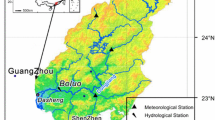Abstract
One of major difficulties with numerical tidal models is accurate inversion of open boundary conditions. A data-driven model based on artificial neural network is developed to retrieve open boundary values. All training data are calculated by numerical tidal model, so the tidal physics are not disturbed. The basic idea is to find out the relationship between open boundary values and the values of interior tidal stations. Case testes are carried out with a real ocean bay named Liaodong Bay, part of the Bohai Sea, China. Four major tidal constituents, M2, S2, O1and K1, are considered in coupled inversion method. Case studies show that the coupled inversion for open boundary conditions can make a more satisfactory inversion for a practical problem.
Preview
Unable to display preview. Download preview PDF.
Similar content being viewed by others
References
Abbott, M.B.: Range of Tidal Flow Modeling. Journal of Hydraulic Engineering 123, 255–277 (1997)
Davies, A.M., Jones, J.E., Xing, J.: Review of Recent Developments in Tidal Hydrodynamic Modeling. Journal of Hydraulic Engineering 4, 278–292 (1997)
Egbert, G.D., Bennett, A.F., Foreman, M.G.G.: TOPEX/POSEIDON Tides Estimated Using a Global Inverse Model. Journal of Geophysical Research 99, 24821–24852 (1994)
Gerritsen, H., Vries, H., Philippart, M.: The Dutch Continental Shelf Model. Quantitative Skill Assessment for Coastal Ocean Models. Coastal Estuarine Studies 47, 425–468 (1995)
Bennett, A.F., Mcintosh, P.C.: Open Ocean Modeling as an Inverse Problem: Tidal Theory. Journal of Physical Oceanography 12, 1004–1018 (1982)
Hall, M.C.G., Cacuci, D.G., Schlesinger, M.E.: Sensitivity Analysis of a Radiative-Convective Model by Adjoint Method. Journal of Atmospheric Science 39, 2038–2050 (1982)
Cacuci, D.G.: The Forward and Adjoint Methods of Sensitivity Analysis. Uncertainty Analysis 282 (1988)
Panchang, V.G., O’Brien, J.J.: On the Determination of Hydraulic Model Parameter Using tThe Adjoint Stste Formulation. Modeling Marine System 1, 5–18 (1989)
Larder: Optimal Control of Open Boundary Conditions for a Numerical Tidal Model. Computer Methods in Applied Mechanics and Engineering 102, 367–387 (1993)
Seiler: Estimation of Open Boundary Conditions with the Adjoint Method. Journal of Geophysical Research 98, 22855–22870 (1993)
Zhu, J., Zeng, Q., et al.: Estimation of Coastal Ocean Model Open Boundary Conditions from Nearshore Tide Gauge Station Using Adjoint Method. Science In China (Series D) 27(5), 462–468 (1997)
Vogeler, A., Schroeter, J.: Fitting a Regional Ocean Model with Adjustable Open Boundaries to TOPEX/POSEIDON data. Journal of Geophysical Research 104, 20789–20799 (1999)
Zhang, K.Q., Marotzke, J.: The Importance of Open-Boundary Estimation for an Indian Ocean GCM-data Synthesis. Journal of Marine Research 57, 305–334 (1999)
Han, G., He, B., Ma, J., et al.: Optimizing Open Boundary Conditions of Nonlinear Tidal Model Using Adjoint Method: The Establishment of Adjoint Model and Twin-Experiment. ACTA Oceanologica SINICA 22(6), 27–33 (2000)
Han, G., Fang, G., Ma, J., et al.: Optimizing Open Boundary Conditions of Nonlinear Tidal Model Using Adjoint Method. Assimilation Experiment for Tide in the Huanghai Sea and the East China Sea. ACTA Oceanologica SINICA 23(2), 25–31 (2001)
Lv, X., Fang, G.: Inversion of the Tides on the Open Boundary of the BOHAI SEA by Adjoint Method. Oceanologia ET Limnologia Sinica 33, 113–120 (2002)
Heemink, A.W., Mouthaan, E.E.A., Roest, M.R.T., Vollebregt, E.A.H., Robaczewska, K.B., Verlaam, M.: Inverse 3D Shallow Water Flow Modeling of the Continental Shelf. Continental Shelf Research 22, 465–484 (2002)
Zhang, A.I., Wei, E., Parker, B.: Optimal Estimation of Tidal Open Boundary Conditions Using Predicted Tides and Adjoint Data Assimilation Technique. Continental Shelf Research 23, 1055–1070 (2003)
Ayoub, N.: Estimation of Boundary Values in a North Atlantic Circulation Model Using an Adjoint Method. Ocean Modelling 12, 319–347 (2006)
Ayoub, N., Stammer, D., Wunsch, C.: Estimating the North Atlantic Circulation with Nesting and Open-boundary Conditions Using an Adjoint Model. ECCO Report, No.10, Scripps Institution of Oceanography (2001), www.ecco-group.org
Foreman, M.G.G., Sutherland, G., Cummins, P.F.: M 2 Tidal Dissipation Around Vancouver Island: an Inverse Approach. Continental Shelf Research 24, 2167–2185 (2004)
Gebbie, G.A.: Subduction in an Eddy-resolving State Estimate of the Northeast Atlantic Ocean. MIT/WHOI PhD Thesis 198 (2004)
Ma, Z., Jing, A.: Data Assimilation Method Applied in Marine Science–Its Significance, System Configuration and Development Situation. Coastal Engineering 24, 83–99 (2005)
Blumberg, A.F., Mellor, G.L.: A Description of a Three-dimensional Coastal Ocean Circulation Model. In: Heaps, N.S. (ed.) Coastal and Estuarine Sciences 4: Three-Dimensional Coastal Ocean Models, Amer. Geophys. Union, pp. 1–16 (1987)
Solomatine, D.P.: Data-Driven Modelling: Paradigm, Methods, Experiences. In: Proc. 5th Int. Conference on Hydroinformatics, Cardiff, UK, pp. 757–763 (2002)
Rumelhart, D.E., Hinton, G.E., Williams, R.J.: Learning Representations by Back Propagating Errors. Nature 323, 533–536 (1986)
Hornik, K.: Approximation Capabilities of Multilayer Feedforward Networks. Neural Networks 2, 359–366 (1991)
Li, M.C., Liang, S.: Application of Artificial Neural Networks to Tide Forecasting. Journal of Dalian University of Technology 47, 101–105 (2007)
Friedrichs, M.A.M.: A Data Assimilative Marine Ecosystem Model of the Central Equatorial Pacific: Numerical Twin Experiments. Journal of Marine Research 59, 859–894 (2001)
Author information
Authors and Affiliations
Editor information
Editors and Affiliations
Rights and permissions
Copyright information
© 2009 Springer-Verlag Berlin Heidelberg
About this paper
Cite this paper
Li, M., Zhang, G., Zhou, B., Liang, S., Sun, Z. (2009). Optimal Inversion of Open Boundary Conditions Using BPNN Data-Driven Model Combined with Tidal Model. In: Yu, W., He, H., Zhang, N. (eds) Advances in Neural Networks – ISNN 2009. ISNN 2009. Lecture Notes in Computer Science, vol 5551. Springer, Berlin, Heidelberg. https://doi.org/10.1007/978-3-642-01507-6_1
Download citation
DOI: https://doi.org/10.1007/978-3-642-01507-6_1
Publisher Name: Springer, Berlin, Heidelberg
Print ISBN: 978-3-642-01506-9
Online ISBN: 978-3-642-01507-6
eBook Packages: Computer ScienceComputer Science (R0)




